Record Crisp And Smooth Sounds With The Best Microphones
After wailing out your brand-new piano piece so often that you can recall it with your eyes closed, it's time to start recording. The only microphone you have is a chewed-up, vintage Singstar piece of plastic, which you think should work. It may be time to consider a new microphone. We compiled a list of the best microphones of 2023 to make your purchase hassle-free.
Comparing The Top Microphones Of 2023
Blue Yeti USB Microphone: Best Overall
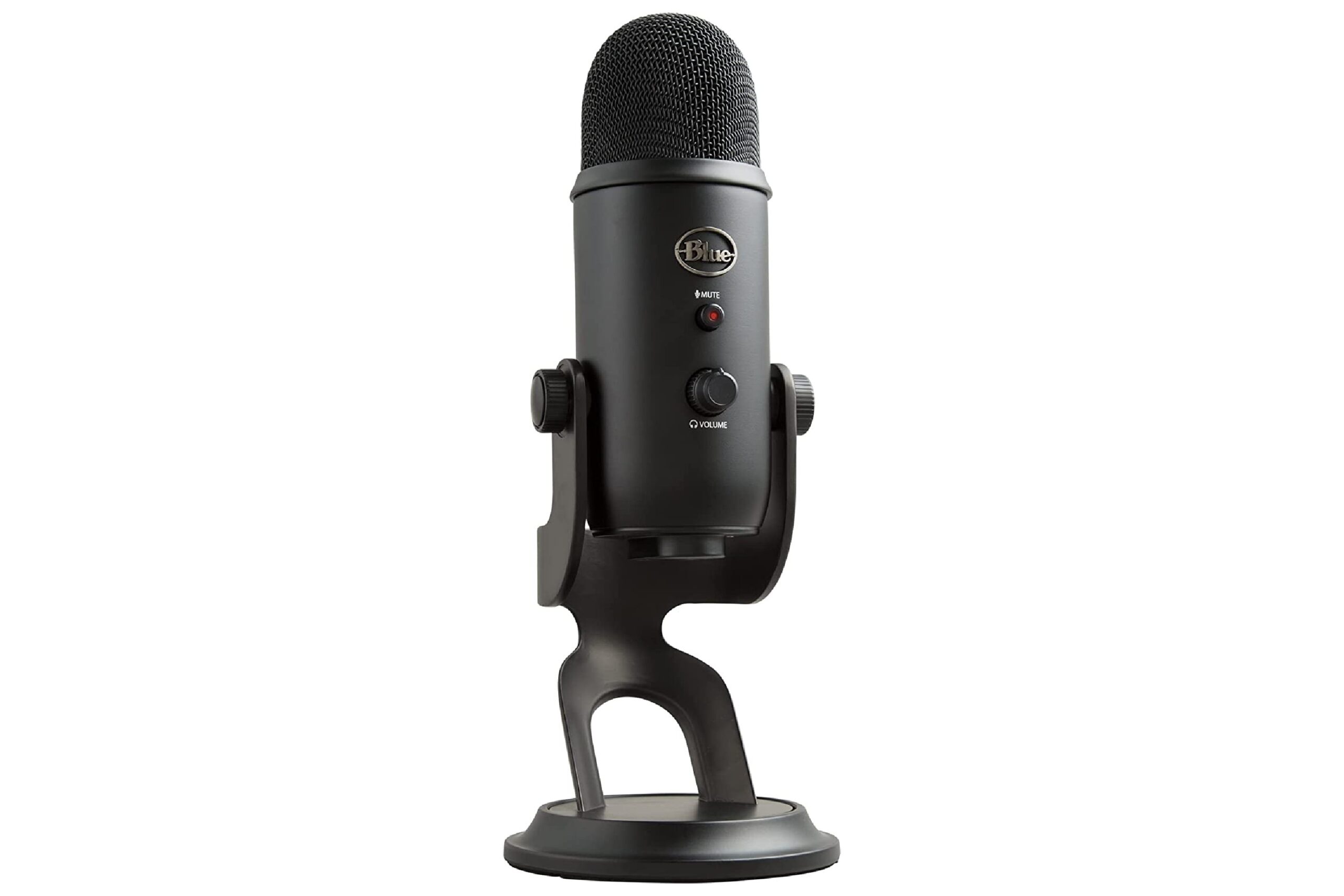
The Blue Yeti USB Microphone is a simple plug-and-play USB device, so there's no need for the user to set up an additional audio interface. All you need to begin recording with the device is to connect the microphone to your laptop or PC's USB port. While this pick may not be a high-end studio microphone, it's still versatile enough to record practically anything you can imagine without having to deal with a complicated setup process.
Most importantly, this microphone has sound quality suitable for online video creators at a relatively affordable price as far as microphones go. Besides producing a good sound, it features a sturdy construction and polished appearance. In general, a USB microphone will enhance the internal pickup on your computer, but the Yeti takes things a step further with three internal condenser capsules that are incredibly sensitive and record crystal-clear and precise sound.
If you're used to inferior microphones, you might be shocked by how this one picks up even the slightest noise. It can pick up sounds like you scrubbing crumbs off your pants, scratching your face and even quiet background noises from adjacent rooms.
Overall, this product is the best on our list because it comes in different colors and styles while offering a high-end recording experience.
Shure SM58 Microphone: Most Sturdy
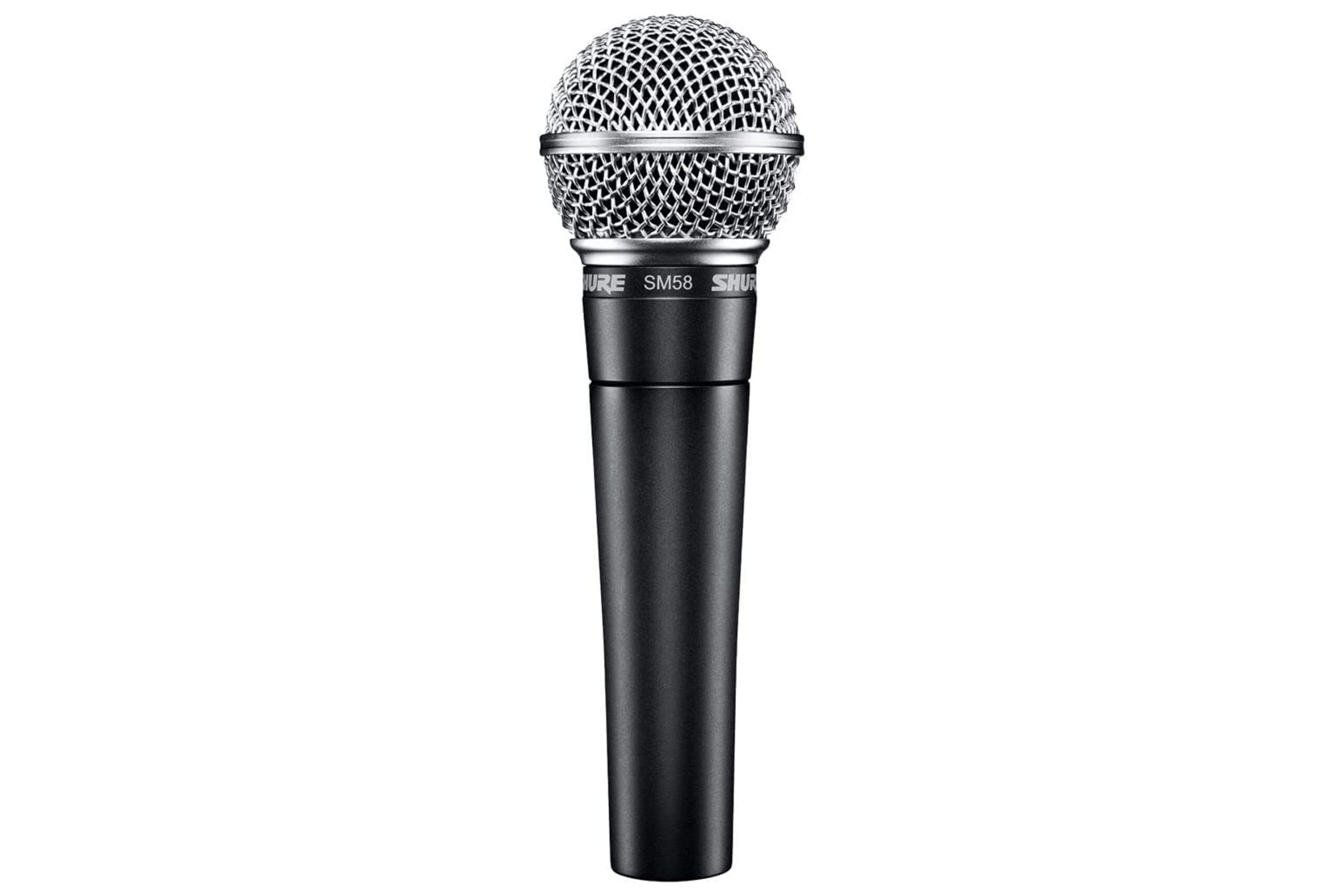
The Shure SM58 Microphone's metal construction and steel grille scream quality and sturdiness, and its tailored frequency response is also helpful for podcasters and vocalists equally.
In terms of build quality, this microphone is a dependable piece of hardware; its modest design emphasizes the value of function over form, and the detachable steel grille makes replacement and cleaning easy. Additionally, this microphone has a "presence peak," which makes your vocals sound rich, warm and smooth rather than imbalanced as they would with a microphone of lesser quality.
The mic has been adjusted to give you a broader frequency response and operates flawlessly across the whole frequency range, enabling rich lows, distinct mids and clear highs. Thanks to the device's noise-canceling features, you may perform on stage without feedback or other unpleasant sounds.
Overall, this pick is an excellent, well-built wireless microphone and is ideal for live performances (extra components required).
Bieturn Wireless Microphones: Most Beginner-friendly
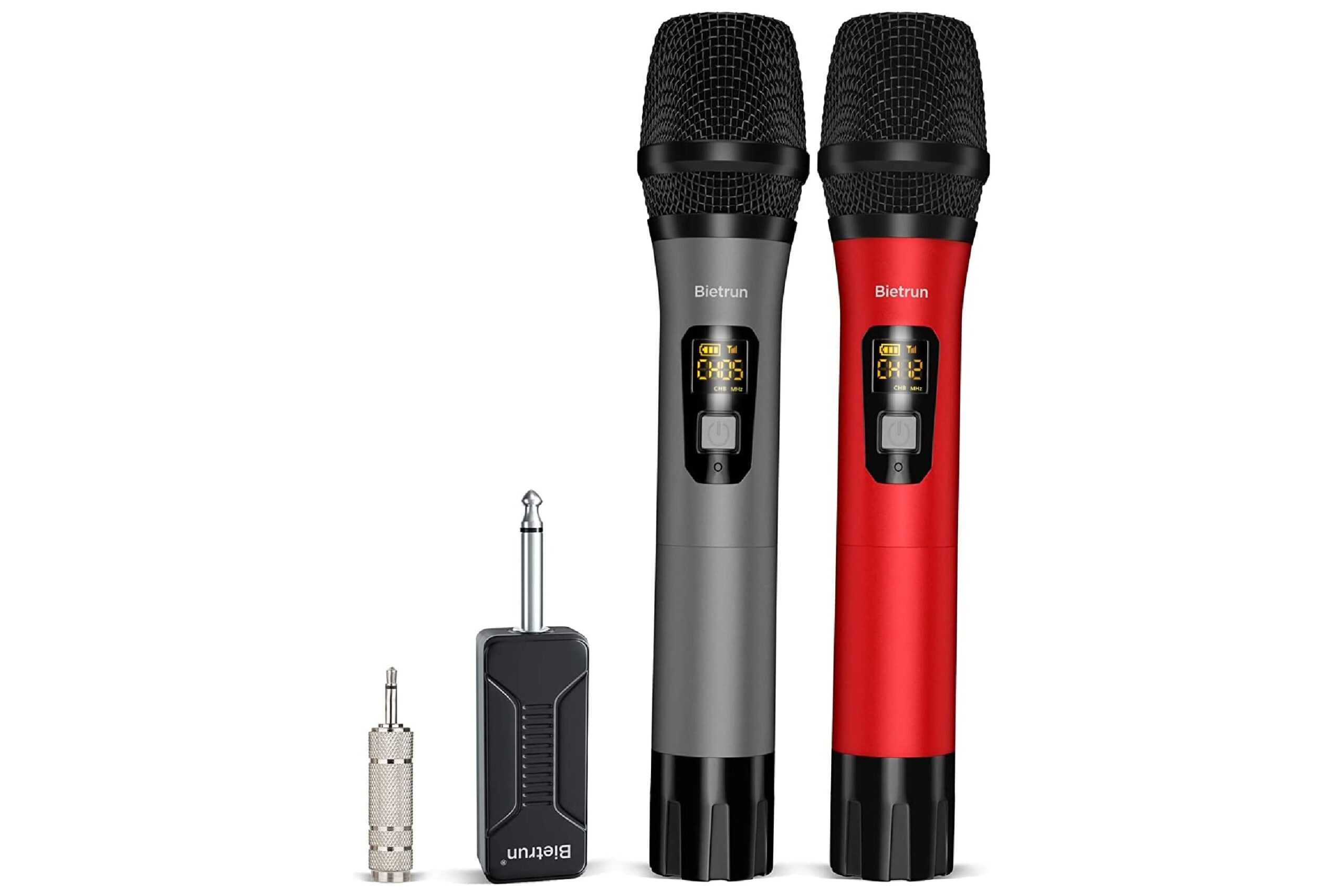
The Bieturn Wireless Microphones are an excellent choice for use in places of worship, karaoke rooms or for singing at parties or weddings. These microphones are made from aluminum alloy, which makes them durable and lightweight, besides providing a good vocal sound. You'll also be able to transmit crisp, warm and smooth sounds thanks to the Bieturn's cardioid polar pattern.
The Bieturns are also easy to install and can be used with other wireless microphones simultaneously — a big advantage for those with little experience. You don't have to worry about low battery either, because these microphones have a display that will alert you to recharge before they run out of juice.
Best of all, these modern microphones have anti-jamming, signal stability and a range of up to 160 feet, making them an excellent choice for public speaking. Just remember that these microphones only work with MIC input, and if you use them in conjunction with additional wireless mics, check that the channel numbers are all unique and spaced out appropriately.
MAONO AU-A04 Microphone Kit: Most Spacious
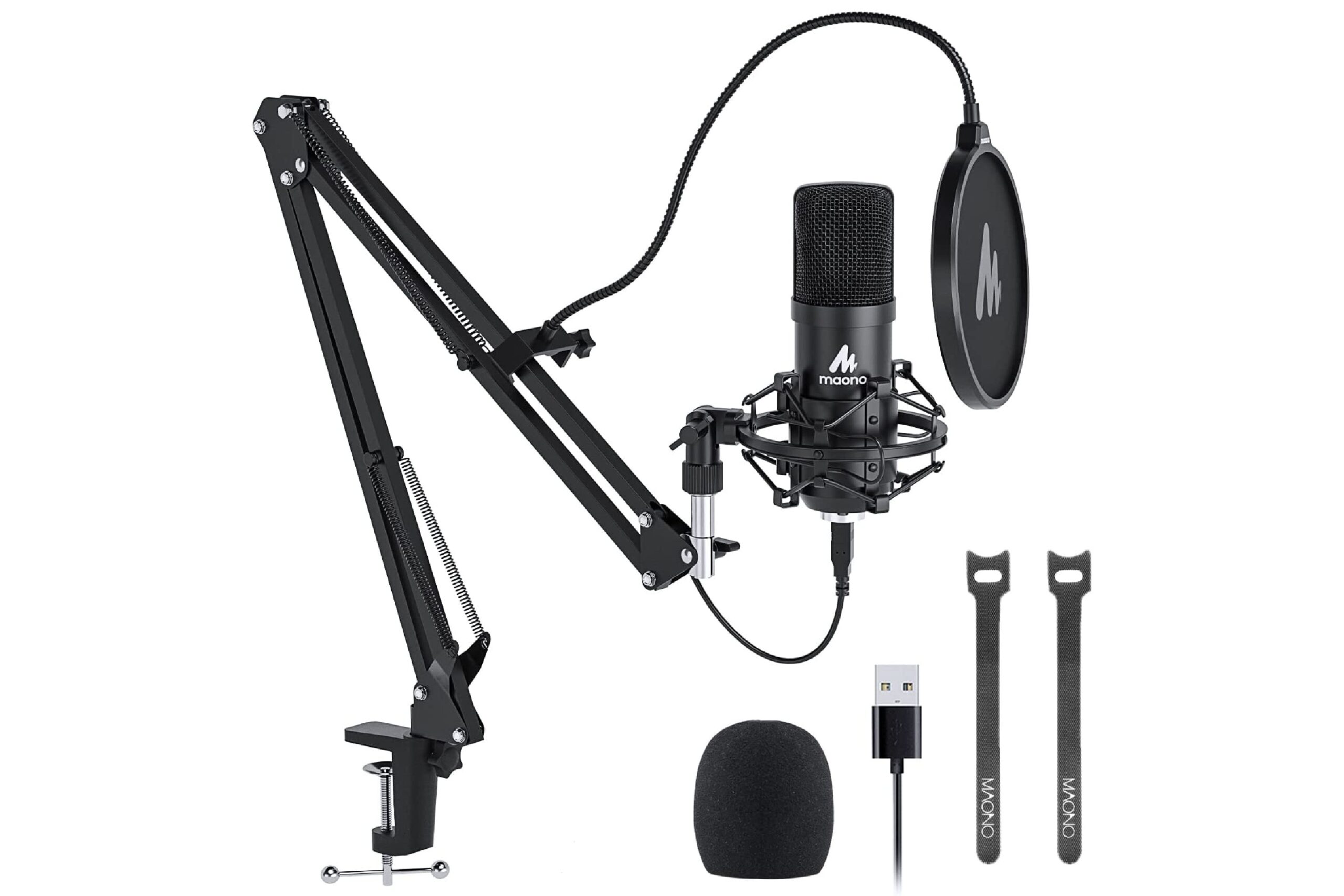
If you want to enhance your audio input but want to avoid going out and buying a ton of separate components, consider the MAONO AU-A04 Microphone Kit. The USB condenser microphone is the primary component of the set. It features a sturdy metal body of substantial weight, and the mic's protection grille also is fairly tough. The microphone has no other controls or inputs except for a USB connector on the bottom.
Thanks to its USB 2.0 data interface, this microphone can be quickly and easily linked to a computer without needing an additional driver or a dedicated sound card. The USB cable's double shielding also keeps interference to a minimum, making it simple to have a professional-sounding voice whether you are using the microphone for a live stream, podcast or another recording medium.
Additionally, this condenser microphone's foam windscreen and pop filter help it record your speech clearly, while the shock mount prevents the mic from moving around thanks to its dampening feature.
Overall, the Maono AU-A04 Microphone Kit is ideal for voiceovers in videos, podcasts, Skype meetings and more.
HyperX QuadCast S Microphone: Quality Features
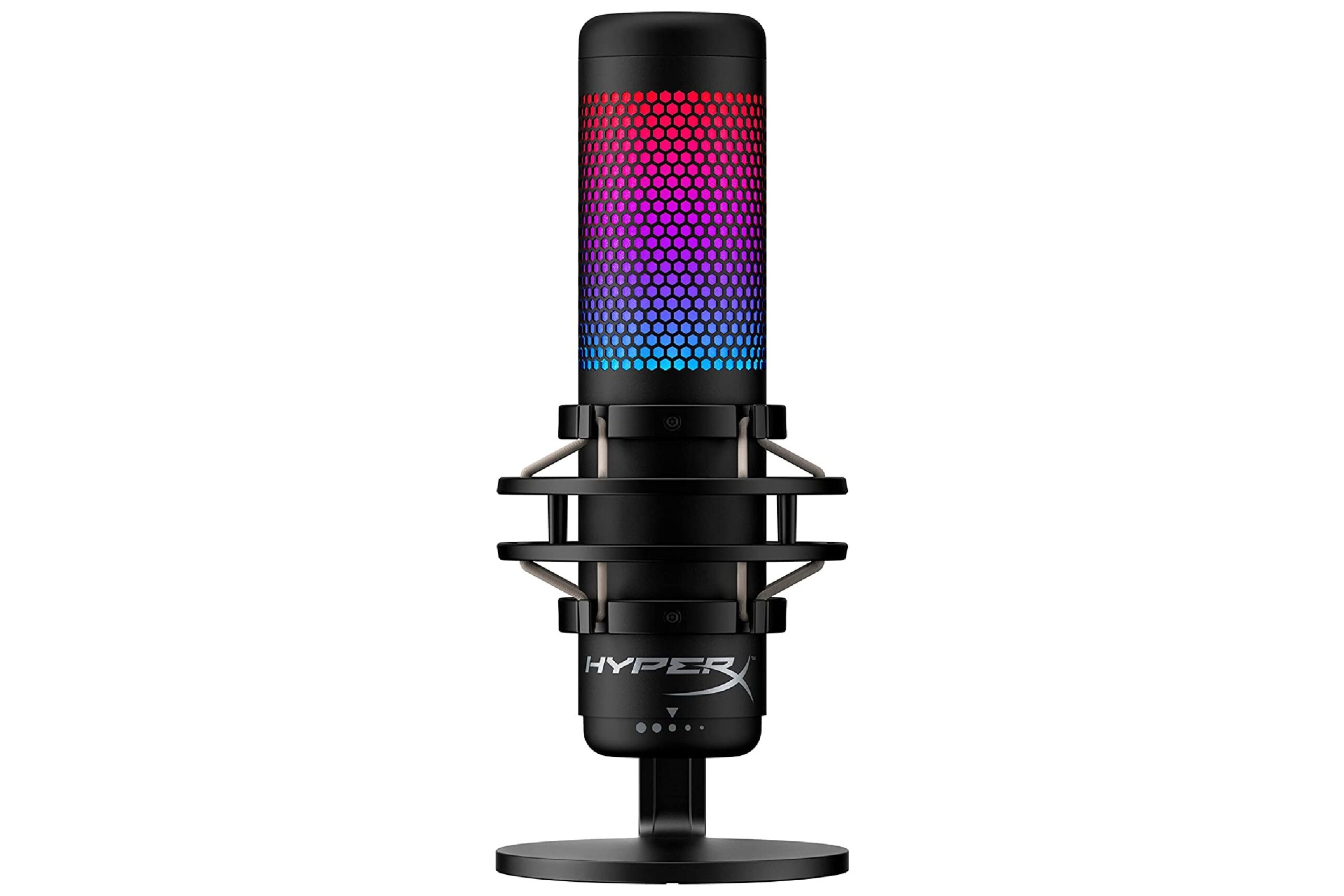
The HyperX QuadCast S Microphone is a terrific choice for gamers who value both aesthetics and excellent sound quality. You'll undoubtedly know the microphone if you regularly watch YouTube videos or live streams. Because it features an integrated shock mount, pop filter and programmable RGB lighting, which slowly changes from one color to another like a lava lamp, it's quite popular with content creators and gamers alike.
A convenient tap-to-mute button on the top of the microphone is helpful for masking coughs and sneezes during video conversations and gaming sessions. The microphone doesn't pick up any audible "thump" because the mute button is sensitive enough to activate at the slightest touch. When you are on mute, the LED indication and RGB lighting also turn off, so you won't ever have to worry about whether or not your friends and coworkers can hear you.
In terms of sound quality, it has a 20Hz to 20kHz frequency response, a 16-bit bit rate and three 14mm condensers that enable it to operate in four different directional patterns. Altogether this RGB-powered device combines excellent audio recording features with a distinctive, customizable look.
Finding A Quality Microphone: A Buyer's Guide
Many factors can affect how well your microphone works, such as the setting in which it's used, the type of interface it's connected to and the presence or absence of other signals or waves. This buying guide will assist you in selecting the ideal microphone for your needs, whether you're building a home studio or playing video games live. Here are some important factors to consider when buying a microphone.
How To Pick The Right Microphone
Polar Patterns
A microphone's polar pattern is its field of sensitivity or the directions it accepts or denies incoming sounds to its central axis. Omnidirectional, bidirectional and unidirectional are the typical classifications.
- Omnidirectional models respond to all sounds.
- Bi-directional microphones start picking up sounds from east and west but not the north and south.
- Unidirectional mics hear only one way.
Generally, unidirectional microphones predominate the market, but other styles can be useful depending on your needs. Examples of polar patterns are:
- super-cardioid
- cardioid
- hyper-cardioid
Knowing your mic's polar pattern helps you decide if it's right for you while rigging it in a loud setting. Some microphones even feature interchangeable polar patterns.
Sensitivity And SPL Handling
These are the common features you'll see when buying a microphone, and the first component is quite simple.
A microphone's sensitivity shows how quiet a sound it can pick up. Remember that lower numbers mean higher sensitivity. Meanwhile, SPL (Sound Pressure Level), measured in decibels (dB), represents the microphone's maximum volume, which is significant for loud instruments like drums.
Impedance
When purchasing a microphone, it's important to ensure its impedance is at the appropriate value. Impedance is how much opposition a microphone has to alternating current (AC) signals. Most microphones have a low impedance and are intended to be used with a low impedance load.
Plugins
XLR and USB are the microphone connector types. USB is the easiest way to link a microphone to a personal computer, DAW or audio recording software. For podcasts, voiceovers and streaming, many USB microphones have one cardioid polar pattern and pick up sounds from the front.
XLR is better for vocals and instruments. XLR microphones cost more than USB microphones and need an audio interface with the right connectors to connect to a computer. But the expense may be worthwhile for those seeking higher quality than USB microphones.
Shock Mount
Using a microphone shock mount helps lessen the background noise in your recording because the shock mount holds the microphone, preventing unintentional bumps.
Compatibility
It's on you to double-check that the microphone you choose works on everything from smartphones to desktop PCs to laptops. If you wish to connect to a phone, you will need an OTG adapter, a piece of hardware that you can buy separately from your microphone.
Different Types Of Microphones
Condenser Microphones
Condenser microphones are common in studios. A condenser microphone's thin conductive diaphragm is near the backplate, making it a capacitor. This capacitor design is normally powered by phantom power from an interface linked to it. The output voltage changes when the diaphragm vibrates due to sound wave pressure.
Different types of condenser microphones fit specific use cases, so it's crucial to pay attention when buying one to make sure it's ideal for your intended use case. Here are the main types:
- Large-diaphragm condenser microphone
- Tube condenser microphone
- Side address condenser microphone
- Small diaphragm microphone
- Dual-diaphragm condenser microphone
Dynamic Microphones
Dynamic microphones use electromagnetism to transform sound into an electrical signal. These have a higher SPL tolerance and are more ruggedly built, making them ideal for on-stage or live applications. Dynamic microphones come in two types:
- Ribbon microphones
- Moving coil microphones
Wireless Microphones
Wireless microphones are comparable to wired microphones, except that they have a transmitter that allows for a longer range of movement. This type of microphone normally requires two elements: a transmitter built within the microphone and a receiver unit that converts the signal further into PA System via a mixer.
USB Microphones
USB microphones have recently become the easiest way to link a microphone to your computer. They are also affordable, making them perfect for those just getting their feet wet in the audio world.
Shotgun Microphones
This is the type of microphone you've probably seen at sporting events and television shows, where someone holds it on a boom arm. This type of microphone has an extremely narrow cardioid pattern and excels at picking up individual sound sources from a long distance.
Boundary Microphones
These microphones gather sound on a flat surface such as a table, floor, ceiling, or wall and are often used in situations requiring substantial coverage.
Tips To Clean Your Dirty Microphone
Keeping your microphone clean is essential to preventing the spread of any germs that may have gathered there. Cleaning makes the user more comfortable and ensures proper microphone hygiene.
- Wipe off the mic boom and cord using an alcohol swab, paying special attention to regions with excessive build-up. If the device is not waterproof, take care not to get it wet. Isopropyl alcohol and a soft cloth will also work. Separate the little sections of the microphone gently to reach all crevices.
- If the mic is waterproof, you use water to clean tricky locations that a wipe may not reach, such as the entrance of the mic aperture.
- After each use, sanitize or replace the windscreens. Most foam pop filters retain moisture (yuck!) and serve as a breeding site for microorganisms. It's best to clean windscreens after each usage by soaking them in soap and water. Allow them to air dry only. Also, keep in mind that smaller foam windscreens are fragile by nature and will decay more quickly.
- After disinfecting, keep windscreens separate from other microphones by sealing each in a zippered bag or a personalized storage case to maintain them in pristine condition for the next use or user.
People Also Ask
How far should I keep my singing microphone?
If you want a great vocal performance, hold the mic at least 2 or 3 inches away from your mouth. As one approaches the microphone, the influence of the proximity effect increases and can result in distortion.
Can I break my mic by yelling into it?
Mics are extremely resilient to loud noises and won't be damaged by yelling. Some microphone diaphragms, such as ribbons, are sensitive to airbursts, such as vocal plosives. Although shouting rarely results in the microphone breaking, the plosives used when shouting may harm the device.
Why do I hear wind noise when my mic is plugged in?
A specific kind of handling noise is wind noise. There are multiple potential origins for this, such as a wet capsule, a defective cable, or even a windscreen that isn't present.
Can I damage my dynamic microphone when using phantom power?
Phantom power (+48 volts) is safe to use with dynamic microphones. There are a few circumstances in which a dynamic microphone may be damaged: when your cables have been wired incorrectly, cross-patching in real time on a patch bay and faulty connections — never connect a microphone before turning off phantom power.
Should I use a windscreen on my mic?
If you're in a noisy place like a large room, that tiny foam ball on your microphone may be more crucial than you realize. The windscreen, as it's called, aids in background noise reduction and shields your microphone from dust and moisture.